 |
||||||||||||||
 |
EAR/Yoshino's room used the $40,000/pr Coltrane speakers by Marten Design whose general appearance pointed at Kharma. Hey, there are only so many ways to attach dynamic drivers to a box, right? Made of carbon fiber laminates, this isn't just any box though. Nor is the frequency response claimed to extend from 20-100,000Hz +/-2dB, that HF extension due to a ¾" diamond membrane tweeter whose first resonance is supposed to occur at - yes, 100KHz. Twin ceramic 9" woofers couple to a 4" ceramic midrange. At 44.5" tall, this is an attractively proportioned speaker, and the Maple, Cherry, Oak or Walnut wooden fascia compliments the high-gloss remainder of the structure beautifully. This exhibit didn't play music just as I entered. | |||||||||||||
Listening instead to Tim de Paravicini holding court while espousing the virtues of his own designs by calling everybody else's deeply flawed had me hurry for the exit. I do appreciate genius-level egos for the results they create. But I don't have to suffer them close-up & personal. Frankly, I despise it when people sell their product by way of stepping on the competition. To my way of thinking, this is very poor form indeed. Good form? Naming your speakers Monk ($3,000), Mingus ($4,500) and Miles ($6,500) as does Leif Marten Olofsson, chief designer at Marten Design. |
||||||||||||||
| EAT (Euro Audio Team) is a new company under the leadership of Jozefina Krahulcova whose sister, if I understood correctly, is married to Mr. Vaic of AVVT. As of CES time, that tube design house axially related to KR Audio seems to have suspended production, hopefully merely temporarily. Combining tube specialists from Switzerland, the UK and the Czech Tesla factory, all final assembly and listening tests of EAT valves is done in Switzerland. Present offerings include: 300BX, 32B, 52B, 300B, KT88, 2A3 standard and mesh. According to Joe Fratus of Art Audio, the 32/52Bs are direct drop-in options for the equivalent VV32B/52BX by KR Audio. He has experimented with these EAT valves and finds them sonically even more dynamic, with a deeper stage and improved S/N ratio. As they're more expensive as well, he intends to offer them as optional upgrades for his Diavolo, Jota and Adagio models. |
 |
|||||||||||||
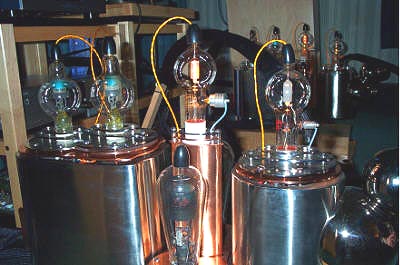 |
 |
|||||||||||||
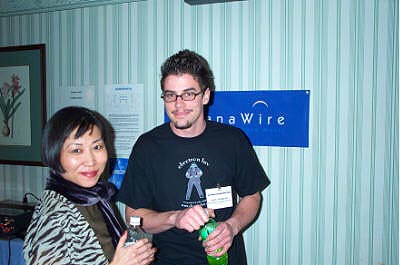 |
||||||||||||||
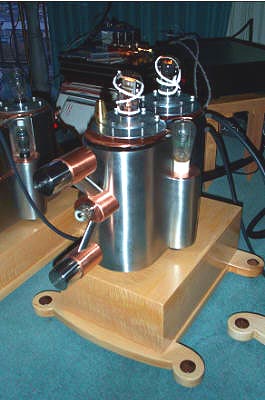 |
||||||||||||||
| For sheer panache and industrial/artistic design in tube amplifiers, the crown goes to young Josh Stippich of Electronluv. Shown above next to my friend Nobuko of KumaDesign (she does all of our site graphics and attended CES for fun but also to promote her services to manufacturers), Josh turned heads at VSAC and decided to pull the same trick at his first CES. He hand-builds his custom amps from stainless steel and copper. He swears by Mercury Vapor tube rectifiers and has a fondness for unique triodes - see the "Russian turret" IMAC 75TLs used, Sukuma-style, as driver and output tubes. Rectifiers here are WE354s and IMAC R51s. But Josh's amps don't just look uniquely inspired. Their sound is a mixture of the AUDIOPAX and Art Audio tubed signatures I'm so fond of. Electronluv amps have the dynamics, drive and linearity of Art Audio and the HF extension, speed and elegance of de Lima's designs. |
||||||||||||||
| Considering his age and highly developed sense of aesthetics, one can only wonder what the future may hold for this young gent who dreams of building a complete recording studio from scratch, developing unique designs from the mic and mic-pre all the way to the console. Click here for our past report and interview on Josh. For both him and Terry Cain of Cain-squared, this was their their first room ever at CES. Confided Terry that the chief brass from Fostex of Japan had been to their suite repeatedly and was due for a visit to his Walla Walla facility in Washington State shortly. This, and gushing hallway scuttlebutt, suggested that both firms made a strong impression. We all know about how that doesn't always line one coffer's in British racing green. Here's to hoping that both Terry and Josh find the financial success in our industry their enthusiasm and commitment so clearly deserves. |
||||||||||||||
 |
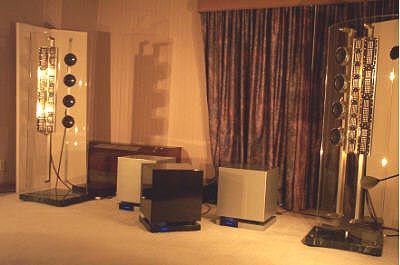 |
|||||||||||||
Element Technologies Group is a new venture spearheaded by Demian Martin, formerly of Entec but long since embedded in Noel Lee's Monster Cable conglomerate. Using Bohlender-Graebner ribbons and line arrays of dynamic woofers crossed over to outboard subwoofers with twin-servo amps and digital display level and setup functions, my immediate reaction to their visual stature? I flashed on Bo Bengtsson, the Swedish ribbon expert who had designed the original Red Rose Music ribbon speakers until Mark Levinson messed one too many times with his designs. Bo then left to establish his own company Transmission Audio. He approached Monster Cable a while back with a licensing proposition for his newest, patent-pending ribbon drivers. Seeing these Element speakers now bearing more than a superficial resemblance to Bo's latest efforts caused a strange sense of synchronicity. Or is it really Genesis/Infinity reborn? Pricing for the E-50 [upper left] is set at $50,000/pr, at double that for the E-100 [lower left]. The Model LFX and LFZ subs are $1,995 and $2,995 respectively. The main difference is the size of their cascaded drivers - 200mm for the smaller, and 250mm for the larger sub. Another Monster Cable connection? According to Dave Berman of Soliloquy, we may soon see Richard Marsh MSD designs reappear under the Monster badge, clad in the look presently embodied by the Monster Cable High-End power line product also designed by Richard. Pricing for these "monster'd marshes" is predicted to be considerably higher than the equivalent Marsh-branded product. Perhaps Jonathan Scull's appearance in the Monster camp was an indicator? Does Noel Lee intend to invade the High-End market? Putting 1 + 1 together, I predict speakers as well as electronics. If someone can pull off this stunt, it's Noel Lee. marketing maestro extraordinaire, with an infrastructure that's the spleen-green envy of all competitors. Time will tell. |
||||||||||||||
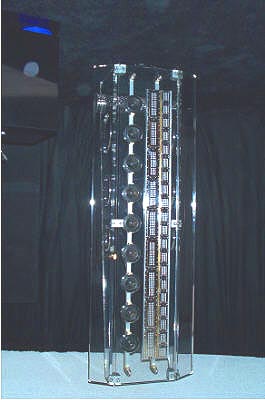 |
||||||||||||||
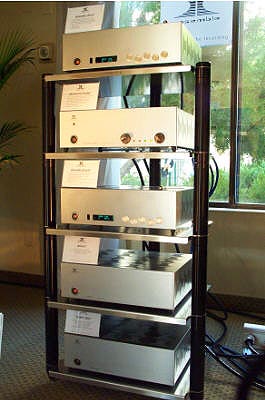 |
||||||||||||||
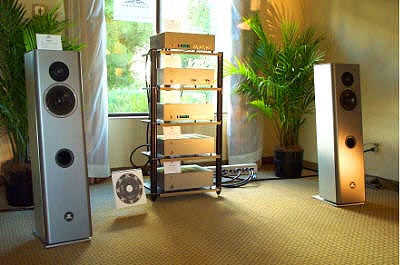 |
||||||||||||||
Certain rooms at CES exuded instant class - from the general appearance to the room decor, from the type of music played to the people tending to visitors, their mien and bearing, the sophistication of their aural observations, the quality of their collateral materials and press kits. In short, the complete package. Call it cultured. Ph.D Urs Wagner and his lovely lady of Swiss firm Ensemble embodied this noblesse to perfection. Their compete systems approach -- from electronics and speakers to cabling and power conditioning -- was one of my favorites. Solid-state? Me? You bet. This setup made music. That's all I care about. Let somebody else busy themselves in the kitchen. Just hand me the fish knife... Ensemble introduced three new digital products, the Dirondo top-loader reference one-box machine ($8,000) and the equivalent Dirondo Drive/Dichrono Hi-Dac/Pre separates ($7,000 ea.) The latter offers defeatable 96kHz upsampling and a slot is reserved for 192kHz once formats settle down. It's a DAC with integral active preamp for direct-drive installations. Not being able to assign responsibility for overall performance excellence to individual components, I can only say that I'd live with this setup as demonstrated in a heartbeat. And this goes beyond pure sonics to include appearance - as I said, the whole package. Compliments to the Wagners and their US representative Brian Ackerman for creating such an oasis amidst the melee of makers attempting to impress visitors by hitting them over the head with a sledgehammer. |
||||||||||||||
| At the risk of instant persecution, I will propose that some of this cosmopolitan savoire-faire is the result of European breeding with its more profound emphasis on comprehensive education and a more varied, substantial exposure to true culture. There, I said it. Incidentally, I noted the same balmy airs in the Nagra exhibit. Ditto for the Zanden room. Which now invalidates my Euro-centric thesis to include the land of Nippon, doesn't it? So much for one-size-fits-all attempts. Artistic Audio is Ensemble's US representative and also handles the brand-new Vacuum Reference cable line. It uses cryogenically treated gold/silver ribbon conductors purled inside a sealed true vacuum chamber for minimal edge contact and dielectric losses. It then is terminated with solderless solid-silver custom RCA jacks ($2,995/1m/pr). A matching speaker cable (ca. $5,000/8'/pr) is forthcoming and expected within the next 45 days. The Heighliner air-dielectric power cord with continuous-cast silver conductors encased in sealed tubes and terminated in plugs fashioned directly from the conductor, then encased in carbon-nylon bodies, is already available ($2,000/1m, $350 for each additional half meter). Short-term review samples are promised. |
||||||||||||||
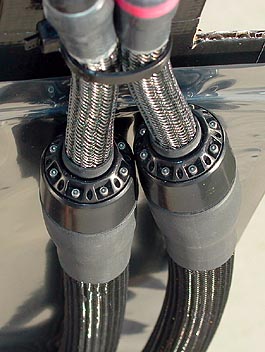 |
||||||||||||||
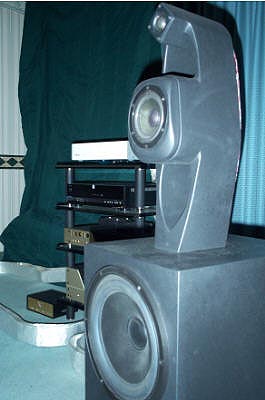 |
If there's one fellow who lives 1st-order designs to the "sub-atomic" level, it's Roy at Green Mountain Audio. I've studied some of his papers only to feel qualified to say this: He definitely understands all the parameters involved. His new Continuum 3 in the Audio Magic room impressed me very much with its spatial and timing precision. The form-follows-function appearance is surprisingly decorator-friendly. This couldn't necessarily be said for some of his former efforts that went after a similar mininum-baffle, adjustable head array. Mark my words, this is a speaker to watch. |
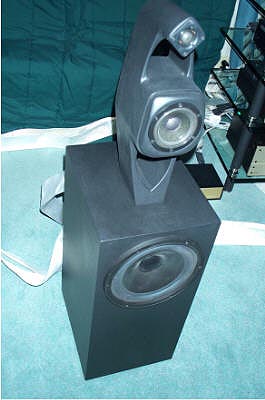 |
||||||||||||
What about that sensual magic when the lights dim and the sheets rustle? One look at Hovland's new Radia ($9,500) tells the tale. It's a 125/200w into 8/4 ohms dual mono solid stater with 26dB of non-inverting voltage gain, a J-FET input stage, active bias control and a TO-3 metal-enclosed transistor output stage. Tipping the scales at 74 lbs, the Radia is quite the compact heavyweight but dressed in haute-couture threads. This was yet another room practicing the sound of one hand clapping when I happened upon it -- a temporary respite from sensory overload, I'm sure -- hence no comments on the sound of the Radia from me. But is that one bitchin' front panel? Who says Americans can't do style? Two thumbs up, way up, just for looks alone. |
||||||||||||||
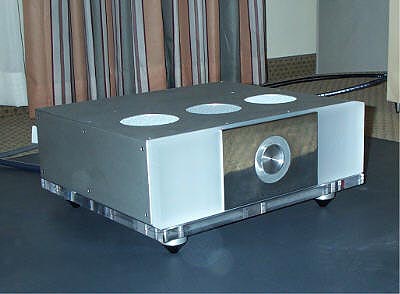 |
||||||||||||||
 |
||||||||||||||
 |
 |
|||||||||||||
 |
||||||||||||||